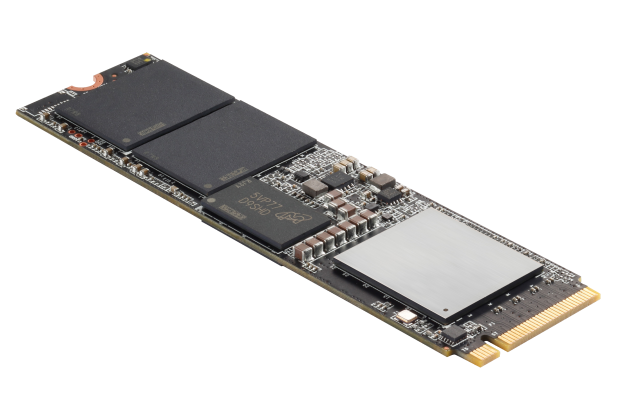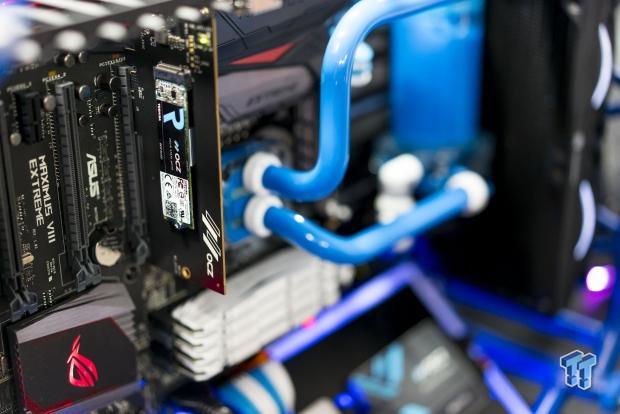Storage News - Page 53
Samsung's new removable UFS storage, 5x faster than microSD cards
Samsung has continued its portable storage dominance, announcing the world's first removable UFS memory card.
The company has the new removable UFS memory cards in 32GB, 64GB, 128GB and 256GB with some pretty crazy speeds to boot. Samsung's new UFS cards have read speeds of up to 530MB/sec, which is 5x faster than even the fastest microSD cards. This means you can download a 5GB file from the UFS card in around 10 seconds, compared to UHS-1 microSD cards where it would take around 50 seconds.
Samsung has also boosted the write speeds on its new UFS cards, with up to 170MB/sec on tap, nearly double that of the fastest microSD cards like SanDisk's Extreme Pro, which writes at up to 100MB/sec. Samsung has crammed this type of speeds into the new UFS cards because of the high-resolution footage being captured by smartphones to action cameras, aerial drones and 360-degree cameras.
Continue reading: Samsung's new removable UFS storage, 5x faster than microSD cards (full post)
QNAP's new NAS is 4K-capable, with 40Gbps of bandwidth for editors
Computex 2016 - QNAP always impress when it comes to NAS systems, with their product line being on show at Computex 2016 once again. The company was showing off their new NAS systems powered by Intel's new 6th generation Core i3/i5/i7 processors, as well as the next-gen TVS-x82T Thunderbolt 2-powered NAS.
The new TVS-x82T line of NAS systems include SATA M.2 SSD and 2.5-inch SSD cache abilities, something that will super-charge your video editing speeds with up to 20Gbps of bandwidth available - enough to handle multiple 4K video transfers, and displays. Nerd alert! The new TVS-x82T lineup comes in 4-, 6-, and even 8-bay solutions depending on your needs.
Then we have the new quad-core TS-831X which offers a "powerful yet affordable NAS solution with two built-in 10GbE SFP+ ports to accelerate applications that require a fast, high-bandwidth and reliable NAS, including intensive data transmission, video storage, streaming and editing". QNAP adds that studios can use the 10GbE storage solution "at a budget price, create a centralized file center for storage, backup and sharing with the rich native apps, and rely on the NAS scalability to accommodate increasing amounts of media files".
Continue reading: QNAP's new NAS is 4K-capable, with 40Gbps of bandwidth for editors (full post)
QNAP goes on the offensive at Computex 2016, pushing QIoT Containers
Computex 2016 - QNAP were not only pushing their usual NAS systems at Computex this year, but their new QIoT Containers - but what in the world are QIoT Containers? They're QNAP's new private IoT cloud platform, which is an "extension to QNAP's robust Container Station that supports LXC and Docker® containerized apps suited for microservices-based architectural patterns as applied to IoT systems".
With QNAP launching its QIoT Containers, the company is also "launching multiple containers (including Ponte, Node-RED, Kafka, Dashing, Freeboard, Redis, MongoDB, RabbitMQ, and MariaDB) that can be used to define private IoT stacks on QNAP NAS. QIoT Containers reduces the expenses of relying on public IoT cloud platforms and provides the easiest, most convenient, and highly-configurable IoT stack for developers to accelerate development with low time to market".
QNAP boss Teddy Kuo explains: "QIoT Containers keeps sensitive data under your control and complements public IoT cloud platforms. We envision that QIoT Containers will help organizations boost microservices and modernize legacy applications to drive more business opportunities".
Continue reading: QNAP goes on the offensive at Computex 2016, pushing QIoT Containers (full post)
Thecus show off the latest in NAS storage at Computex 2016
Computex 2016 - Thecus were on top of their game at Computex this year, showing off the latest advances in their network attached storage (NAS) products. Thecus had their entire line of NAS products on show at the Foxconn IPC group booth, too.
The company had their upgraded window NAS series, as well as teasing their next-gen enterprise, 16-bay NAS that is powered by a Skylake-based Intel processor and DDR4 RAM. The company also took the time to make a big deal of their upcoming N4810, a new 4-bay multimedia NAS that is capable of 4K playback. The Thecus N4810 is powered by a quad-core Intel Celeron N3160 processor that clocks at up to 2.24GHz under burst, with 4GB of RAM and dual Ethernet ports.
For more information on Thecus' NAS products, check out their website, here.
Continue reading: Thecus show off the latest in NAS storage at Computex 2016 (full post)
SanDisk's new Ultra Dual Drive USB Type-C drive capable of 150MB/sec
Computex 2016 - SanDisk unveiled their new SanDisk Ultra Dual Drive USB Type-C flash drive during Computex 2016, with the new generation drive featuring a new retractable design, higher speeds, more capacity, and more.
Vice President of SanDisk's Product Marketing, Dinesh Bahal explains: "With its reversible connector, impressive speeds, and multi-purpose potential, USB Type-C is a game-changer. More Type-C devices are entering the market and through our Type-C mobile drives, we can offer consumers a complete line of mobile storage solutions. The new SanDisk Ultra Dual Drive USB Type-C flash drive now provides more than twice the capacity and offers the flexibility to quickly and conveniently move photos, videos and files between devices, as well as the freedom to expand device capacity".
The new SanDisk Ultra Dual Drive USB Type-C flash drive comes in up to 128GB with a reversible USB Type-C connector and a standard USB Type-A connector that will allow you to connect it up to your PC, notebook, or even smartphone and tablet. We have USB 3.1 performance pushing up to 150MB/sec, which is more than enough speed to throw huge files onto the drive, at high speeds. The new drive arrives in capacities of 16GB, 32GB, 64GB and 128GB with pricing of $19.99, $29.99, $39.99 and $69.99, respectively.
Continue reading: SanDisk's new Ultra Dual Drive USB Type-C drive capable of 150MB/sec (full post)
Plextor's new PCIe-based SSD is capable of 2.5GB/sec reads!
Something we missed during our Computex 2016 coverage was the new Plextor M8Pe series SSD, which is the company's new PCIe-based SSD which arrives with the super-fast 32Gb/s PCIe interface.
The new Plextor M8Pe series SSDs arrive in 128GB, 256GB, 512GB and even 1TB sizes, all powered by the Marvel 88SS1093 series processor, baked onto Toshiba-made MLC NAND flash. The 128GB version of the drive reads at up to 1.6GB/sec while writes are slower at 500MB/sec with up to 120,000/130,000 IOPS R/W 4K random access. Moving up to the 256GB model, which is capable of up to 2GB/sec reads and 900MB/sec writes with 210,000/230,000 IOPS random access.
The larger 512GB model packs reads speeds of up to a whopping 2.3GB/sec while write speeds are 1.3GB/sec, with 260,000/250,000 IOPS random access, while the 1TB version has some insane numbers, with up to 2.5GB/sec reads and up to 1.4GB/sec writes with 280,000/240,000 IOPS random access.
Continue reading: Plextor's new PCIe-based SSD is capable of 2.5GB/sec reads! (full post)
Micron announces new 2TB SATA and NVMe 3D NAND SSDs
Computex 2016 - Micron has just revealed a new 3D NAND-powered 2TB SSD duo aimed at supercharging workstations with high-performance, low-power consumption storage.
Micron's blazing-fast SSD duo consists of the cost-competitive Micro 1100 SATA and the high-end Micron 2100 PCIe NVMe solid state drives. The Micron 1100 SSD sports the industry's highest capacity TLC 3D NAND storage at 2TB that takes "power to the min and capacity to the max." The 1100 series SSD is specifically designed to supercharge general applications with ultra-fast speeds, providing instantaneous data access, program loads, and incredibly speedy boot times. To give you an idea how fast the Micron 1100 SSD is, it performs random operations up to 900 times faster than traditional HDDs and features low-power states to make it 98% more power efficient.
The Micron 2100 SSD is the company's first PCIe NVMe SSD, and unlocks a "new dimension of storage with lower latency and unbridled performance for demanding workloads." The Micron 2100's NVMe form factor significantly broadens data bandwidth, with up to four times the bandwidth of SATA SSDs, ultimately reducing data lag and bottlenecks for high-end gaming. The NVMe protocol enables the 2100 to deliver a staggering 1900X faster reads than everyday HDDs.
Continue reading: Micron announces new 2TB SATA and NVMe 3D NAND SSDs (full post)
OCZ displays RD400 series SSD for hardcore gamers, reads at 2.6GB/sec
Computex 2016 - OCZ didn't have too much to show off at Computex 2016, but what they did have was impressive. OCZ was displaying their RD400 series SSD, which is a PCIe-based SSD on the NVMe 1.1b standard and M.2 form factor.
Remember that Toshiba acquired OCZ in 2014, and now we have the super-fast OCZ RD400 series SSD which is capable of a huge 2.6GB/sec in sequential reads, and 1.6GB/sec sequential writes.
OCZ's RD400 series drive comes in 128GB, 256GB, 512GB and even 1TB.
Continue reading: OCZ displays RD400 series SSD for hardcore gamers, reads at 2.6GB/sec (full post)
Samsung PM971-NVMe shrinks the SSD in more ways than one
Samsung is mass producing a NVMe PCIe solid state drive in a single ball grid array (BGA) package -- an industry first.
The PM971-NVMe as it's known features 16 of Samsung's 48-layer 256Gb V-NAND chips, one 20nm 4Gb LPDDR4 mobile DRAM chip, and a high-performance Samsung controller. For storage, you get a maximum of 512GB; for speed, you'll see 1,500MB/s and 900MB/s read and write, respectively, with the aid of the company's proprietary Turbowrite technology, as well as 190K and 150K random read and write IOPS, making it 1500 times faster than an HDD.
Size and weight are some of the key draws: the drive measures 20mm x 16mm x 1.5mm, weighs just one gram, boasts a volume one-hundredth that of a 2.5" SSD or HDD, and a surface area one-fifth of what you'd see with an M.2 SSD. As such, it can fit just as easily in an ultra-slim notebook as it can your desktop PC.
Continue reading: Samsung PM971-NVMe shrinks the SSD in more ways than one (full post)
Microsoft does the impossible, uses actual synthetic DNA to store data
Current data storage techniques rely nearly solely on typical electronic techniques that have been used for years, but they are slightly limited if we wish our data to last for longer than 20 years in cold storage without being switched out. Microsoft is teaming up with Twist Bioscience to explore using DNA as a means of long-term storage. And it's working splendidly.
They've agreed to purchase ten million long oligonucleotides, or DNA, from Twist Bioscience to start encoding actually digital data into the nucleotides therein. Twist Bioscience says that using DNA is advantageous in many different ways over the usual disk or NAND-based solutions. Data could potentially last for up to 2,000 years, far longer than usual, and the amount of data that can be stuffed into just a gram is somewhere around on trillion gigabytes, or a zettabyte, of data. That's astounding.
The approach that they'll be using appears to be de novo or from the very beginning. That is, they'll be making the DNA and not using already present DNA, infusing it with data, then sequencing it so it cannot be re-obtained unless re-sequenced. DNA storage is something that has been explored since 1988, when a small amount of information was put into a small strand of already living DNA. There are plenty of obstacles to making this a viable technology in the future, but thus far, even with current techniques, it could potentially be a magnificent alternative to current archival techniques.
Continue reading: Microsoft does the impossible, uses actual synthetic DNA to store data (full post)



